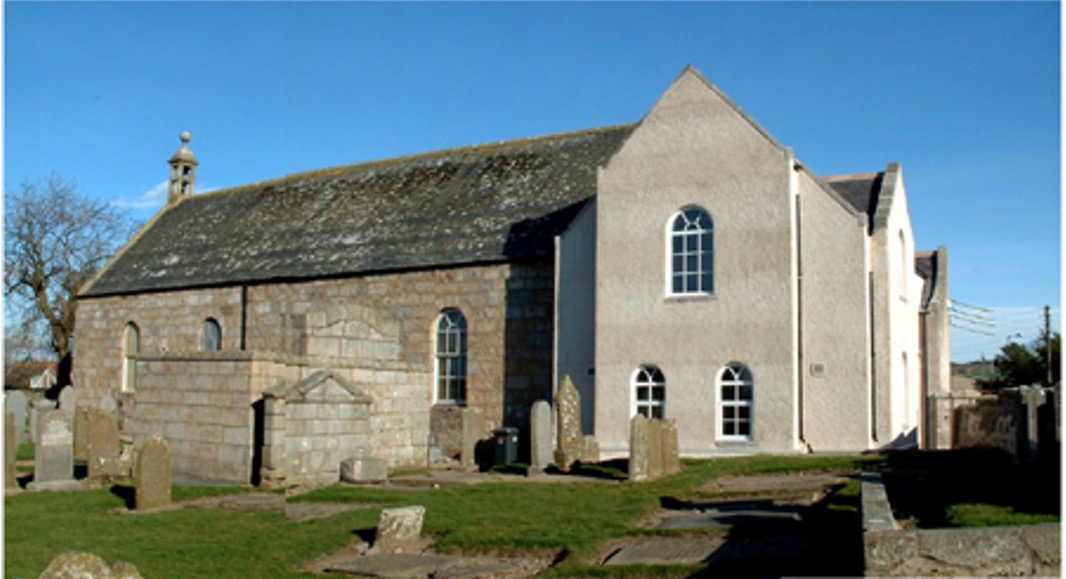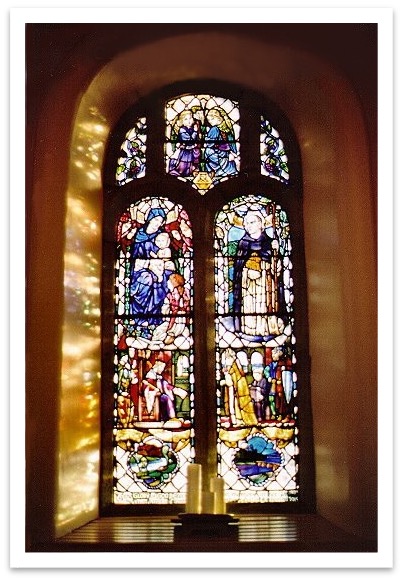THE PARISH CHURCH OF NEWMACHAR
The parish church of New Machar was taken out of the older larger parish dominated by the Cathedral of St. Machar, situated on the banks of the river Don. St. Machar's Cathedral is traditionally sited where the river ran a course shaped like a Shepherd's Crook, this being the pastoral emblem of Christianity, shown in the shape of the Bishop's staff of office.
Early registers refer to the 'Upper Parochin' of St. Machar, and later to Upper Machar. The modern name of New Machar appears in 1637 and in 1641 the chaplain of Monycabock was removed from his chapel there to be the parish priest at the new church in the village. In fact, research shows that the chapel at Moneykebbock as it is now called, is the older established place of worship. It was founded by St. Colm (the name is sometimes rendered St. Comb), who was a disciple of St. Drostan, the founder of pictish Christianity, in the 11th Century.
Three other chapels were established in the parish subsequently, during the Middle ages; one to the Virgin Mary at Straloch, another to the Virgin at Clubs Goval, one at Bishop's Manor on a small Island in Loch Goul, on the Bishop's Loch. The chapel at Straloch is now in ruin, but in 1908 a small chapel to St. Mary was built near the Manor House.
In the village, the original 17th Century church was replaced by the present church, which was built in 1791, parallel with the 10 mile stone on the main road from Aberdeen. It was a plain rectangular building, with round windows at each end and galleries round three sides of the interior. The original entrance was at the Belfry end of the church, approached by the side gate. The new and present entrance was added in 1840 and included the stairs vestry and double doors.
The Manse was built a little earlier, in 1781, and was thoroughly renovated in 1840, when the very typically Victorian Bay Windows were added.
As a matter of interest - in the 19th Century, the manse was valued at £25. The Stipend amounted to £66.2.6., and amounts of the Glebe produce, such as various beer oats and barley were all carefully assessed as part of the Living. Also of interest is the fact that in 1871 the years church collection was noted as £25.14.11 ¾d., of which £10 was expended in the relief of the poor.
In 1843 the Free Church was built, which stood, until 1975 where the shop 'Home Care' now is. It became successively the United Free Church, then the Church of Scotland and was finally re-united with the Parish Church in 1932. In 1858 the Episcopal Church at Whiterashes was the gift of Major Ramsay of Straloch. It has Memorial Windows by Sir Ninian Comper.
The new Cemetery to the south of the Parish Church was opened in 1905 and has a War Memorial beside the graves of 58 Sailors of the Royal Navy, who died at Kingseat Hospital when it was a Naval Hospital during the War.
The Parish Church was renovated and reconstructed in 1913, with new seating, organ and Communion Table installed. A Colourful Stained Glass Window showing St. Machar and aspects of parochial history was designed by Or. Douglas Strachan and was the gift of Mrs. Margaret Crombie in 1915 as a family memorial. The rest of the Windows are of paned, leaded, light-coloured glass; those on the south side of the church noticeably not as fine as those opposite, because in the days of the old three-sided gallery they would have been less in the view of the congregation.
There were once three "Sabbath Schools' as recorded in 1840 but now only one centred in the parish church, meeting in the Day School with whom the church has established strong links.
The Parish Church of New Machar is an officially listed original late 18th Century building; although altered and added to it remains a landmark, sited as it is on a slight rise in the centre of the village. With the rapid expansion of the population and numbers of houses springing up, creating outlying additions to the village, it is hoped the Church will remain symbolically the centre, the outward sign of a growing community still with a heart and soul. (Researched and written by J.M. Burnett).
Some interesting notes -- There were several schools in the Parish until recent years -- Disblair- Whiterashes - Parkhill Craigie. Now only the New Machar Primary School caters for the children from these areas.
The Population of the Parish - in 17 55 - 1,911; in 1782 1,000; in 1811 - 945; in 1901 - 926. The population was expected to rise to over 2,000 by the 1980's.
According to old records the Parish rises from 128 feet above sea level at Dyce bridge to 190ft at Rosehall; the Church is 300ft; New Lodge Straloch 326 ft; the wood at Highlands is 486 ft and the highest point is given as Changehill - 620 ft.
The Parish used to be included in the Aberdeen Presbytery but with regionalisation was put into the Gordon District and therefore the Presbytery is now the Gordon Presbytery. At the present time it meets at lnverurie.

